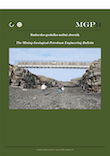Simulation of CO2 injection in a depleted gas reservoir: A case study for Upper Miocene sandstone, Northern Croatia
DOI:
https://doi.org/10.17794/rgn.2019.1.12Keywords:
carbon capture and storage (CCS); depleted gas reservoir; CO2 storage simulation, the Upper Miocene sandstone, Northern CroatiaAbstract
Carbon capture and storage (CCS) technology is a beneficial greenhouse gas mitigating strategy carried out in the last 20 years. Depleted gas reservoirs are promising candidates for the storage of carbon dioxide (CO2). Therefore, a depleted gas reservoir in the Upper Miocene sandstone located in Northern Croatia was taken as an example. The purpose of this study was to compare CO2 storage capacity obtained with two analytical equations to total storage capacity obtained through the simulator, in order to validate the equations. The first equation takes the average reservoir pressure and available production data into account, while the other one is more general and includes produced volume, CO2 density and formation volume factor of the original fluid. The tools used for these calculations were Schlumberger PVTi software, in which the equation of state was obtained, and ECLIPSE (E300 Module) which is a reservoir engineering simula- tor used for reservoir behaviour prediction. The results confirmed analytical solutions, indicating that, depending on the depth, the mass of the CO2 that can be injected is twice as big as the mass of CH4 produced. The results of analytical solutions, 16.7 × 10**6 m**3 and 14.6 × 10**6 m**3, are in accordance with the results obtained by the simulation of CO2 injection in depleted reservoirs - 16.2 × 10**6 m**3. Based on this, a conclusion is derived that these analytical solutions can be used as a first approximation of injection in a depleted gas reservoir.
Downloads
Published
How to Cite
Issue
Section
License
Copyright (c) 2018 authors and journal

This work is licensed under a Creative Commons Attribution 4.0 International License.
Creative Commons-BY
Authors who publish with this journal agree to the following terms:
In agreeing this form, you certify that:
- You read the ethical codex of the RGN zbornik available at journal web.
- You submitted work is your original work, and has not previously been published and does not include any form of plagiarism.
- You own copyright in the submitted work, and are therefore permitted to assign the licence to publish to RGN zbornik.
- Your submitted work contains no violation of any existing copyright or other third party right or any material of an obscene, libellous or otherwise unlawful nature.
- You have obtained permission for and acknowledged the source of any illustrations, diagrams or other material included in the work of which you are not the copyright owner.
- You have taken due care to ensure the accuracy of the work, and that, to the best of your knowledge, there are no false statements made within it.
- All co-authors of this submitted work are aware of, and in agreement with, the terms of this licence and that the submitted manuscript has been approved by these authors.
Publication licence
You retain copyright in your submitted work, according to journal license policy (CC-BY). By signing this form you agree that RGN zbornik may publish it under the publication licence. In summary the licence allows the following:
Anyone is free:
- To copy, distribute, display, and perform the work.
- To make derivative works.
Under the following conditions:
- The original author must always be given credit.
- The work may not be used for commercial purposes.
- If the work is altered, transformed, or built upon, the resulting work may only be distributed under a licence identical to this one.
Exceptions to the licence
In addition to publishing the work printed under the above licence, RGN zbornik will also enable the work to be visible online.
The journal editorial can change the licence rules anytime but it cannot retroactively restrict author(s) rights.


